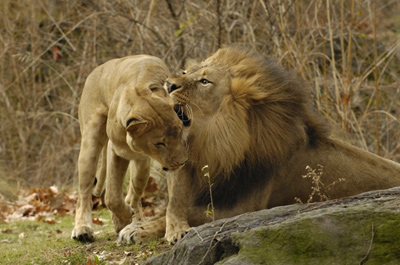Photo: Male lion licking a female’s head
Photo: Male lion licking a female’s head
Julie Larsen Maher, special to mongabay.com
January 8, 2008
A hippo photo safari by Julie Larsen Maher of the Wildlife Conservation Society
Bronx Zoo’s newest lions, male M’wasi and female Sukari, have recently been introduced on the Zoo’s Africa Plains. A typical lion greeting is quick, lasting less than a minute, and includes touching heads.

Lion male licking female’s head at the Bronz Zoo. Photo by Julie Larsen Maher © WCS |
Outside of Africa’s largest national parks, lions are disappearing rapidly. They are losing habitat to human encroachment. Field scientists Luke Hunter and Laurence Frank of the Wildlife Conservation Society, headquartered at the Bronx Zoo, are working to maintain African predators in unprotected areas, by helping people and livestock to live with lions.
Watch for news on the lions this spring on www.bronxzoo.com. The Bronx Zoo is open every day with many indoor and outdoor exhibits to explore.
Related
How to save the world’s big cats – An interview with Luke Hunter of WCS
Big cats are some of Earth’s largest and most threatened predators. Long persecuted as perceived threats to livestock and humans, hunted for their skins and purported medicinal values, and losing critical habitat to deforestation and conversion for agriculture, big cat populations have dwindled around the world for the past century. Recent years have seen the extinction of two sub-species of Indonesian tiger, the Caspian Tiger from western Central Asia, a sub-species of clouded leopard from Taiwan, and the Barbary lion from the wild in North Africa. Meanwhile, populations of the Iberian lynx, Asiatic cheetah and Amur leopard have fallen so low that they would be functionally extinct without current conservation efforts. Tiger populations have declined from more than 100,000 at the turn of the century to less than 6,000 today, while cheetah number are estimated at less than 15,000. Even lion populations have dropped: from over 100,000 one hundred years ago to probably less than 40,000 today.